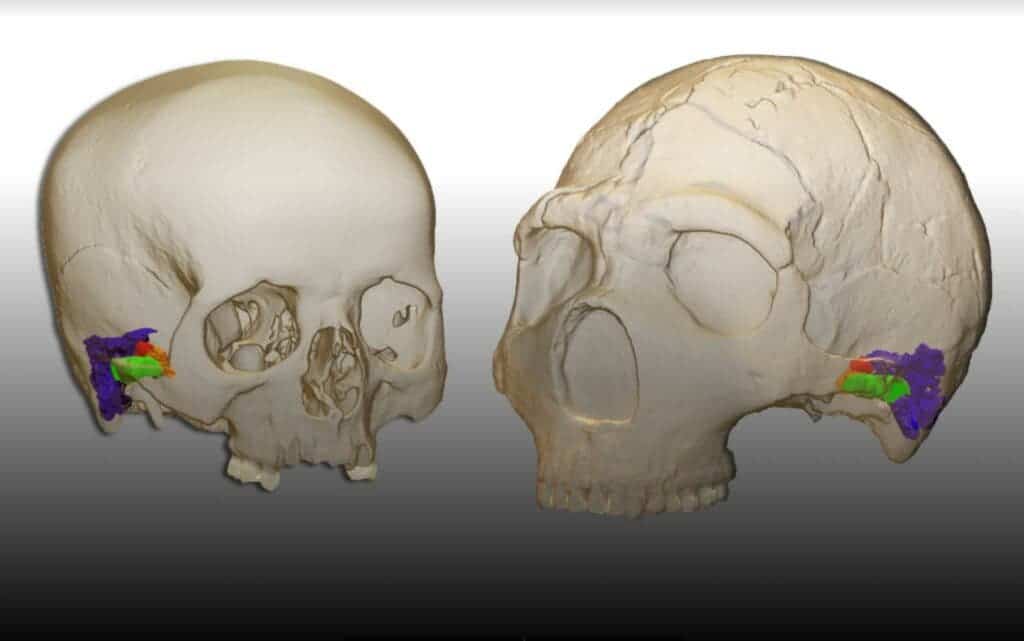
With each new study, scientists’ perceptions on Neanderthals have shifted away from that of mindless brutes to highly complex hominids — a new study is cementing the notion that our extinct cousins were very human-like. One central question in human evolution is whether spoken language was employed by other species in the Homo lineage. A study published today confirms that Neanderthals were indeed linguistically capable.
“This is one of the most important studies I have been involved in during my career”, says Rolf Quam, an anthropology professor at Binghamton University and co-author of the new study. “The results are solid and clearly show the Neandertals had the capacity to perceive and produce human speech. This is one of the very few current, ongoing research lines relying on fossil evidence to study the evolution of language, a notoriously tricky subject in anthropology.”
The Atapuerca Mountains in north-eastern Spain may not look like much. They feature gentle slopes and a rather dry landscape, interrupted from time to time by forests and the occasional river. But these mountains hold a karstic environment that is key to understanding how humans came to be, and what life was for our early ancestors.
The most important site is a cave called Sima de los Huesos (Pit of Bones). Anthropologists have recovered over 5,500 human remains which are at least 350,000 years old from this site. The remains belong to 28 individuals of Homo heidelbergensis, an archaic hominin that lived from approximately 700,000 years to 300,000 years ago. Scientists believe that H. heidelbergensis is the ancestor of Homo neanderthalensis.
For their study, Quam along with colleagues at the Universidad Complutense de Madrid performed high resolution CT scans of Atapuerca fossils in order to produce virtual 3D models of the ear structure. The scientists generated models for Homo sapiens and Neanderthals, as well as for the ancestors of the Neanderthals.
The ear models were then inputted into software that can estimate hearing abilities based on the structure of the ears up to 5 kHz, which is most of the frequency range of modern human speech sounds.
Compared with the Atapuerca fossils, the researchers found that the Neanderthals had slightly better hearing in the 4-5 kHz range, which closely resembles modern humans.
The study also assessed the frequency range of maximum sensitivity, also known as the occupied bandwidth, for each species. The wider this bandwidth, the easier it is to distinguish complex sounds and to deliver a clear message in the shortest amount of time.
Once again, compared to their Atapuerca ancestors, Neanderthals showed a wider bandwidth resembling modern humans.
“This really is the key,” says Mercedes Conde-Valverde, professor at the Universidad de Alcalá in Spain and lead author of the study. “The presence of similar hearing abilities, particularly the bandwidth, demonstrates that the Neandertals possessed a communication system that was as complex and efficient as modern human speech.”
This begs the question: what did a Neanderthal language sound like? According to the researchers, one of the most intriguing findings of the study is that Neanderthal speech likely included an increased use of consonants.
“Most previous studies of Neandertal speech capacities focused on their ability to produce the main vowels in English spoken language. However, we feel this emphasis is misplaced, since the use of consonants is a way to include more information in the vocal signal and it also separates human speech and language from the communication patterns in nearly all other primates. The fact that our study picked up on this is a really interesting aspect of the research and is a novel suggestion regarding the linguistic capacities in our fossil ancestors,” Quam said.
These documented improvements in auditory capacity in Neandertals mirrors increasing complexity in stone tool technology, domestication of fire, and possible symbolic practices. We know, for instance, that Neanderthals also painted, fashioned jewelry, and employed abstract thinking in which symbols or images are used to represent objects, persons, and events that are not present.
As such, the study suggests that increasingly complex behaviors coevolve with increasing efficiency in oral communication. More insights may be gleaned once the researchers extend this investigation to other species of Homo.
“These results are particularly gratifying,” said Ignacio Martinez from Universidad de Alcalá in Spain. “We believe, after more than a century of research into this question, that we have provided a conclusive answer to the question of Neandertal speech capacities.”


